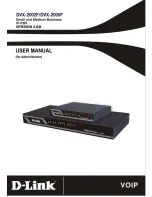
X2002 User’s Guide
167
C
H A P T E R
8
QoS
8.1 Overview
This chapter shows you how to configure the X2002’s Quality of Service (QoS)
settings in the
Configuration > PBX > Server Configuration > QoS
screen.
Quality of Service (QoS) refers to both a network's ability to deliver data with
minimum delay, and the networking methods used to control the use of
bandwidth. Without QoS, all traffic data is equally likely to be dropped when the
network is congested. This can cause a reduction in network performance and
make the network inadequate for time-critical applications such as VoIP.
The following problems can occur on a congested network with poor QoS settings:
•
Latency
- delay of packet delivery. This can cause echoes during a
conversation.
•
Jitter
- variations in delay of packet delivery. This could cause strange sound
effects. The X2002 utilizes a jitter buffer to minimize the effects of jitter.
•
Packet Loss
- packets are dropped due to an overwhelming amount of traffic
on the network. Some degree of packet loss will not be noticeable to the end
user, but as packet loss increases the quality of sound degrades.
The X2002 can be configured to change the priority field of IP packets for all
outgoing RTP (Real Time Protocol) packets. The X2002 supports Type of Service
(ToS) and Differentiated Services (Diffserv) for implementing QoS. Configure the
X2002 with the QoS settings that your network uses for VoIP.
8.1.1 What You Can Do in this Chapter
Use the
QoS
screen to configure the type of QoS you want to use, and to specify
the level of service you want to use for the X2002’s traffic on your network. See
.
8.1.2 What You Need to Know
The following terms and concepts may help you as you read through the chapter.
Summary of Contents for X2002
Page 2: ......
Page 24: ...Table of Contents X2002 User s Guide 24...
Page 25: ...25 PART I User s Guide...
Page 26: ...26...
Page 40: ...Chapter 2 How It Works X2002 User s Guide 40...
Page 99: ...99 PART II Technical Reference...
Page 100: ...100...
Page 124: ...Chapter 5 Network Deployment X2002 User s Guide 124...
Page 166: ...Chapter 7 Auto Provision X2002 User s Guide 166...
Page 170: ...Chapter 8 QoS X2002 User s Guide 170...
Page 248: ...Chapter 16 Click To Talk Group X2002 User s Guide 248...
Page 252: ...Chapter 17 Group Access Code X2002 User s Guide 252...
Page 304: ...Chapter 19 Auto Attendant X2002 User s Guide 304...
Page 312: ...Chapter 20 LCR X2002 User s Guide 312...
Page 346: ...Chapter 22 Call Services X2002 User s Guide 346...
Page 380: ...Chapter 25 Status Observation X2002 User s Guide 380...
Page 402: ...Chapter 27 Call Detail Record CDR X2002 User s Guide 402...
Page 410: ...Chapter 28 ACD Logs X2002 User s Guide 410...
Page 416: ...Chapter 29 Administrator Accounts X2002 User s Guide 416...
Page 424: ...Chapter 30 Diagnostics X2002 User s Guide 424...
Page 426: ...Chapter 31 X2002 User s Guide 426...
Page 446: ...Chapter 32 Remote Management X2002 User s Guide 446...
Page 448: ...Chapter 33 TFTP Management X2002 User s Guide 448...
Page 462: ...Chapter 35 License Control X2002 User s Guide 462...
Page 482: ...Chapter 36 Web Portal X2002 User s Guide 482...
Page 508: ...Chapter 39 Product Specifications X2002 User s Guide 508...
Page 548: ...Appendix C Legal Information X2002 User s Guide 548...
Page 562: ...Index X2002 User s Guide 562...


































